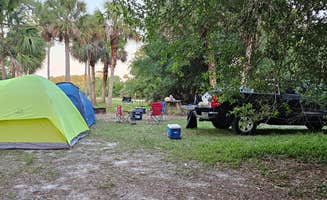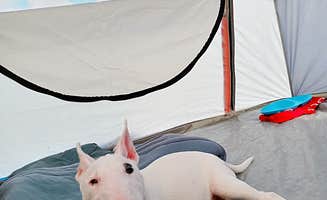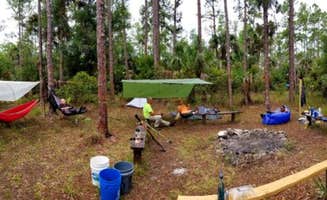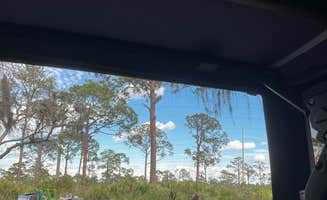Tent camping near Okeechobee, Florida offers diverse wetland experiences in South Florida's inland region. The area surrounding Lake Okeechobee typically experiences humid subtropical conditions with summer temperatures averaging 90°F and winter lows rarely dropping below 50°F. Seasonal considerations affect campsite selection, as summer months bring frequent afternoon thunderstorms and increased mosquito activity while winter provides more comfortable camping conditions with lower humidity.
What to do
Fishing adventures: Indian Prairie Canal Recreation Area provides unique boat-in camping opportunities. "We camped here in June. Yes it was hot and sweaty but thats what the lake is for. This is very sweet free camping. There maybe 10 sites here and you can't quite literally take a boat to the campsite," notes camper Daniel S.
Wildlife observation: Jonathan Dickinson State Park offers primitive camping with excellent wildlife viewing opportunities. "This campground as beautiful as it is remote, just the way I like it. Perfect if you seek serene solitude," shares Pavel T. about the Kitching Creek primitive sites.
Hiking trails: Winter months (November-February) provide the best conditions for exploring the interconnected trail systems. The Ocean to Lake Trail connects several primitive campsites, allowing backpackers to plan multi-day hikes with overnight stops at designated camping areas. Many trails feature interpretive signage identifying native plants and animals.
What campers like
Privacy levels: Loop 4 Campground offers secluded tent sites with natural separation. "The camp ground is large, can easily accommodate 30+ people and is well maintained. I had an occasional cell signal. Plenty of trees for hammock camping and shade," reports J R.
Water access: Campsites near Lake Okeechobee's rim canals provide direct water access for fishing and boating. At Uncle Joe's Motel & Campground, one camper noted, "Located on the rim canal of Lake Okeechobee, we stayed for two nights to go to the Hendry County Speedway for dirt track racing and basically caught a Bass every time we cast a line."
Free camping options: Several campgrounds in the region offer no-cost camping with basic amenities. "FREE stay, register at the SFWMD site and request a permit. Each site has a fire pit and picnic table. Various trees at the camp sites to provide shade," shares a camper about DuPuis Campground.
What you should know
Water conditions: Water sources at primitive sites often require treatment. "The water from the pump came out with a purple tinge and smelling of Sulphur. I opted to get my drinking water from the creek across from the camping area after filtering it," notes a Loop 4 camper.
Wildlife awareness: Alligators are common throughout the region's waterways. "The creek farther down had adolescent gators, nothing to worry about. But I kept my eyes pealed for sudden movements when I got the water," reports a camper at Loop 4.
Seasonal closures: Some campgrounds close during summer months or hunting seasons. Check with land management agencies before planning trips, especially to more remote sites. Water levels can fluctuate dramatically between wet and dry seasons, affecting accessibility.
Permit requirements: Little Gopher and other primitive sites on public lands may require advance permits or registration. "A primitive campground on the Ocean to Lake trail, it is well maintained by the FTA-Lox chapter. A large site capable of housing multiple tents and hammock setups," explains J R.
Tips for camping with families
Safety precautions: Keep children within sight near any water bodies due to alligator presence. Teach kids to recognize potentially dangerous wildlife including snakes and insects common to the area.
Spacing considerations: Family camping areas can become crowded during peak seasons. "The place is comfortable and the boathouse are clean. They should implement more distances between the camping sites. It was really crowded," notes a camper about Highlands Hammock State Park.
Activity planning: Schedule ranger-led programs at state parks for educational opportunities. "Seemed like many family groups were there. Lots of kids wandering around. Quiet time was moderately observed," shares a camper about state park accommodations.
Site selection: Blue Cypress County Park offers family-friendly sites with basic amenities. "This is a neat little plot of land to base some fishing from. There's no shade in the camping area, but there are two fire pits and two picnic tables, so bring a pop up or shelter tent for the midday sun," advises B+J S.
Tips from RVers
Space limitations: Many primitive camping areas near Okeechobee cannot accommodate large RVs. "The roads in the campground are a bit narrow, traffic can go both ways (even though they are only one lane!), and the dump station is not in the best place," notes a visitor to Highlands Hammock State Park.
Seasonal bookings: Winter months (January-March) represent peak RV season in the region when northern visitors seek warmer weather. Make reservations 6-11 months in advance for popular sites during this period.
Weather preparedness: Summer afternoon thunderstorms can develop quickly. RVers should secure awnings and outdoor equipment when leaving their sites, even briefly, during summer months.





